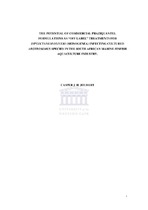| dc.description.abstract | Aquaculture is a vast industry all over the world and has increased significantly
during the past 30 years. In South Africa, finfish aquaculture farms stretch from
Gansbaai to as far as Richards bay with the potential of extending into Mozambique. The future success of this fast growing industry in South Africa
strongly relies on the development of the supporting sector such as government
legislation, sponsorship, participation of the pharmaceutical industry and research
and development in aquatic organism health management. Diplectanum oliveri
Williams, 1989, a monogenean gill parasite of both Argyrosomus japonicus
(Temminck & Schlegel, 1843) (dusky kob) and A. inodorus Griffiths & Heemstra,
1995 (silver kob) is currently regarded in South Africa as the most persistent
ectoparasite associated with the culture of both fish species, causing pathological
tissue changes in the areas associated with attachment and feeding which can
result in stock losses. The egg production of D. oliveri was used to evaluate and
develop a method to quantify monogenean infections on fish, by counting the
eggs produced by infra-populations of these parasites over a 24-hour period and to
determine the reliability of this method as a non-invasive/non-destructive method
to quantify the intensity of an individual infra-population of parasites on a single
host. Currently, Diplectanum spp. on dusky kob are being controlled in local
mariculture facilities using methods and drugs that are traditionally used for
monogeneans (flukes) and are regarded as effective. Most of these drugs are,
however, no longer approved for use in food fish and none of them has proven to
be very effective in controlling D. oliveri in culture facilities, which can result in
subsequent re-infections of epidemic proportion. Currently, there are no
anthelmintics registered for aquaculture in South Africa. An registered
anthelmintic used in terrestrial animals (sheep, goats, cattle and ostriches)
containing praziquantel was tested at various concentrations and exposures against
D. oliveri on A. japonicus to determine the efficacy of two different formulations
and the potential for "off label" use. The 20 ppm (high) praziquantel concentration
treatments eliminated all adult parasites, but caused significant measureable stress
and affected the central nervous system of the fish, which resulted in death of all
fish in the solution group after 18 hours. The 2 ppm (low) concentrations failed to
remove all adult parasites. Although both the 2 hour (short) exposure/high
concentration and 24 hour (long) exposure/low concentration of the suspension
formulation were effective, but only the short exposure/high concentration
eliminated all adult parasites with little change in behaviour by the treated fish. | en_US |

